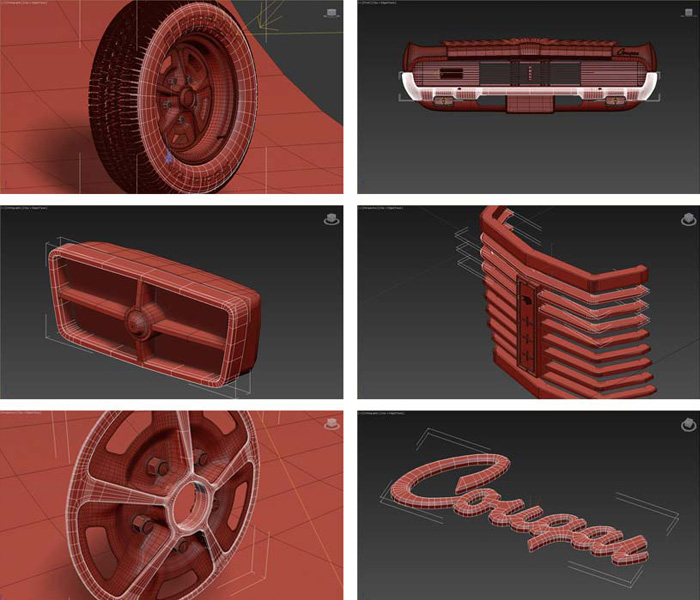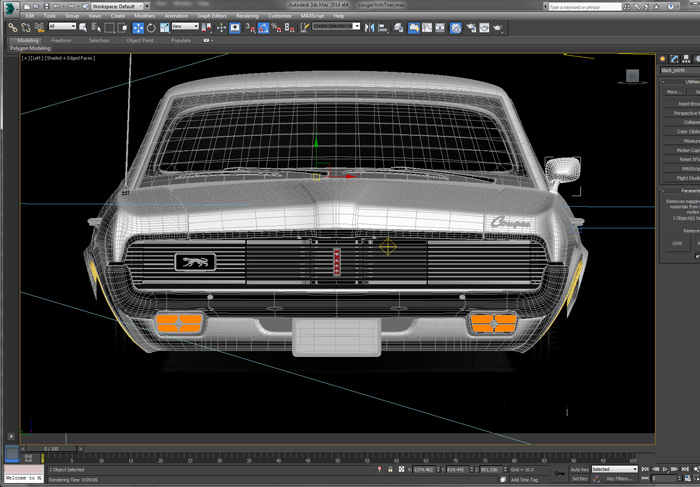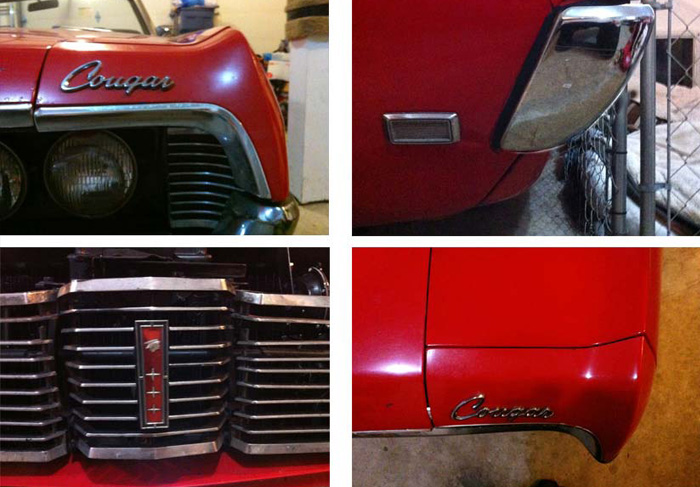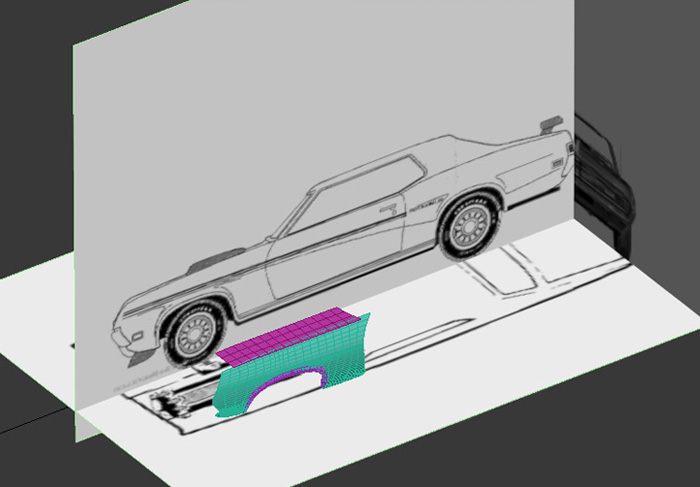1969 Mercury Cougar
This is an ongoing 3D illustration project featuring a classic 1969 Mercury Cougar Coupe. During my college years, I owned a hardtop version of this car, and I currently own a convertible model of the same vintage. Given the considerable time and effort required to create a complete interior, including the dashboard and seats, I have commenced the project with the coupe version. As time permits, I intend to undertake the creation of a convertible version as well.






The Process
This project was truly a labor of love for me, driven by the fond memories of my college years at Washington State University when I used to drive my 1969 Cougar through the scenic Palouse region. This iconic car had a special history; my aunt had purchased it brand new in 1969 and later handed it down to me for my college commute. When I inherited it, the odometer already showed 167,000 miles, but the original 351 Windsor V8 engine still roared with strength. Over the years, the Medium Gold Poly paint had faded to a less appealing brown, and the car bore its share of dents, windshield pings, and a crushed right front fender. Throughout my college journey, I lovingly maintained and repaired it as needed.
After graduating and securing a job, I embarked on a mission to restore the Cougar to its original glory. What you see here is a meticulously crafted 3D rendering of the final result. I've always been enamored with the car's aesthetic. While the 1967 and 1968 models may have been more popular, I firmly believe that the lines and design of the 1969 Cougar outshine them both. In today's world, where cars tend to blend together in sameness, I find them uninspiring. The 1960s marked a golden era in automotive design, where designers had the freedom to create vehicles without the constraints of federal safety, fuel economy, and emission-control regulations. Bumpers weren't solely for taking bumps, hardtop roofs didn't necessitate B-pillars for reinforcement, and the focus was on aerodynamics rather than regulatory compliance.
But as the decades passed, the epicenter of car design shifted from Detroit to Washington, with corporate budgets reallocated toward regulatory adherence. Consequently, today's roads are filled with vehicles that often appear indistinguishable from one another.
On a personal note, I've recently acquired another Cougar, a convertible of the same year and make. While it presents its own set of challenges, I'm eager to embark on the journey of restoring it to its original splendor, just as I did with my beloved hardtop Cougar.
After graduating and securing a job, I embarked on a mission to restore the Cougar to its original glory. What you see here is a meticulously crafted 3D rendering of the final result. I've always been enamored with the car's aesthetic. While the 1967 and 1968 models may have been more popular, I firmly believe that the lines and design of the 1969 Cougar outshine them both. In today's world, where cars tend to blend together in sameness, I find them uninspiring. The 1960s marked a golden era in automotive design, where designers had the freedom to create vehicles without the constraints of federal safety, fuel economy, and emission-control regulations. Bumpers weren't solely for taking bumps, hardtop roofs didn't necessitate B-pillars for reinforcement, and the focus was on aerodynamics rather than regulatory compliance.
But as the decades passed, the epicenter of car design shifted from Detroit to Washington, with corporate budgets reallocated toward regulatory adherence. Consequently, today's roads are filled with vehicles that often appear indistinguishable from one another.
On a personal note, I've recently acquired another Cougar, a convertible of the same year and make. While it presents its own set of challenges, I'm eager to embark on the journey of restoring it to its original splendor, just as I did with my beloved hardtop Cougar.



I used the initial blueprints and drawings to establish the car's overall dimensions, length, and width, as well as to outline its distinctive design features. However, when these blueprints proved insufficient for creating detailed technical views, I resorted to photographing my own car and meticulously reconstructing it section by section. The majority of the intricate details you see here were derived from close-up images.
Numerous online tutorials provide step-by-step guidance on crafting 3D car models using blueprints as a foundation, and I followed one such tutorial available in Autodesk's Area section. Typically, locating outlines for most cars is straightforward, but obtaining front, rear, and side view blueprints specifically for the 1969 Cougar proved more challenging than expected. Eventually, I acquired a side view of a 1970 Eliminator, a front-end image of a '69 convertible, and a top view of the '69 coupe. It's crucial to note that these references weren't traditional blueprints and lacked orthographic flatness, presenting perspective challenges. They were a compilation of drawings and photos sourced from various individuals on the internet, necessitating meticulous alignment and adjustments in Photoshop. After cleaning and resizing them, I placed them on planes in a cutaway arrangement, as illustrated here, ultimately achieving a successful integration.
The final car model was a culmination of several components, each built separately and subsequently imported into a core file. You can identify numerous individual pieces, such as the turn signals, tires, and front grille components, which were initially crafted independently and then seamlessly incorporated into the overall structure. Notably, vehicles from this era boasted an abundance of chrome and intricate details, demanding significant time and effort to accurately replicate their appearance.
Numerous online tutorials provide step-by-step guidance on crafting 3D car models using blueprints as a foundation, and I followed one such tutorial available in Autodesk's Area section. Typically, locating outlines for most cars is straightforward, but obtaining front, rear, and side view blueprints specifically for the 1969 Cougar proved more challenging than expected. Eventually, I acquired a side view of a 1970 Eliminator, a front-end image of a '69 convertible, and a top view of the '69 coupe. It's crucial to note that these references weren't traditional blueprints and lacked orthographic flatness, presenting perspective challenges. They were a compilation of drawings and photos sourced from various individuals on the internet, necessitating meticulous alignment and adjustments in Photoshop. After cleaning and resizing them, I placed them on planes in a cutaway arrangement, as illustrated here, ultimately achieving a successful integration.
The final car model was a culmination of several components, each built separately and subsequently imported into a core file. You can identify numerous individual pieces, such as the turn signals, tires, and front grille components, which were initially crafted independently and then seamlessly incorporated into the overall structure. Notably, vehicles from this era boasted an abundance of chrome and intricate details, demanding significant time and effort to accurately replicate their appearance.


